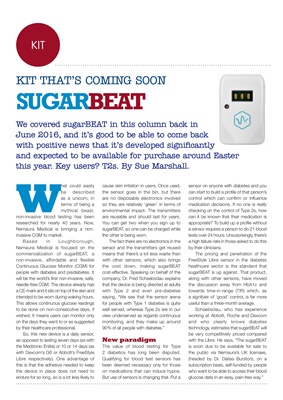
KIT
KIT THAT'S COMING SOON
SUGARBEAT
We covered sugarBEAT in this column back in June 2016,
and it's good to be able to come back with positive news that
it's developed significantly and expected to be available for
purchase around Easter this year. Key users? T2s.
By Sue Marshall.
What could easily be described as a
unicorn, in terms of being a mythical
beast, non-invasive blood testing has
been researched for nearly 40 years.
Now, Nemaura Medical is bringing a noninvasive CGM to market.
Based in Loughborough,
Nemaura Medical is focused on the
commercialization of sugarBEAT, a
non-invasive, affordable and flexible
Continuous Glucose Monitor (CGM) for
people with diabetes and prediabetes. It
will be the world's first non-invasive, safe,
needle-free CGM. The devise already has
a CE-mark and it sits on top of the skin and
intended to be worn during waking hours.
This allows continuous glucose readings
to be done on non-consecutive days, if
wished. It means users can monitor only
on the days they want to or as suggested
by their healthcare professional.
So, this new device is a daily sensor,
as opposed to lasting seven days (as per
the Medtronic Enlite) or 10 or 14 days (as
with Dexcom's G6 or Abbott's FreeStyle
Libre respectively). One advantage of
this is that the adhesive needed to keep
the device in place does not need to
endure for so long, so is a lot less likely to
cause skin irritation in users. Once used,
the sensor goes in the bin, but there
are no disposable electronics involved
so they are relatively 'green' in terms of
environmental impact. The transmitters
are reusable and should last for years.
You can get two when you sign up to
sugarBEAT, so one can be charged while
the other is being worn.
The fact there are no electronics in the
sensor and the transmitters get reused
means that there's a lot less waste than
with other sensors, which also brings
the cost down, making sugarBEAT
cost-effective. Speaking on behalf of the
company, Dr. Fred Schaebsdau explains
that the users that the device is being
directed at adults with Type 2 and even
pre-diabetes saying, "We see that the
sensor arena for people with Type 1
diabetes is quite well served, whereas
Type 2s are in our view underserved as
regards continuous monitoring, and they
make up around 90% of all people with
diabetes."
New paradigm
The value even of blood testing for Type
2 diabetics has long been disputed.
Qualifying for blood test sensors has
been deemed necessary only for those
on medications that can induce hypos.
But use of sensors is changing that. Put a
sensor on anyone with diabetes and you
can start to build a profile of that person's
control which can confirm or influence
medication decisions. If no one is really
checking on the control of Type 2s, how
can it be known that their medication is
appropriate?
To build up a profile without a sensor
requires a person to do 21 blood tests
over 24 hours. Unsurprisingly, there's a
high failure rate in those asked to do this
by their clinicians.
The pricing and penetration of the
FreeStyle Libre sensor in the diabetes
healthcare sector is the standard that
sugarBEAT is up against. That product,
along with other sensors, have moved
the discussion away from HbA1c and
towards time-in-range (TIR) which, as
a signifyier of 'good' control, is far more
useful than a three-month average.
Schaebsdau, who has experience
working at Abbott, Roche and Dexcom
and who clearly knows diabetes
technology estimates that sugarBEAT will
be very competitively priced compared
with the Libre. He says, "The sugarBEAT
is soon due to be available for sale to
the public via Nemaura's UK licensee,
(headed by Dr. Dallas Burston), on a
subscription basis, self-funded by people
with Type 2 diabetes who want to be able
to access their blood glucose data in an
easy, pain-free way."
Beat it
Beyond supplying the sugarBEAT sensor,